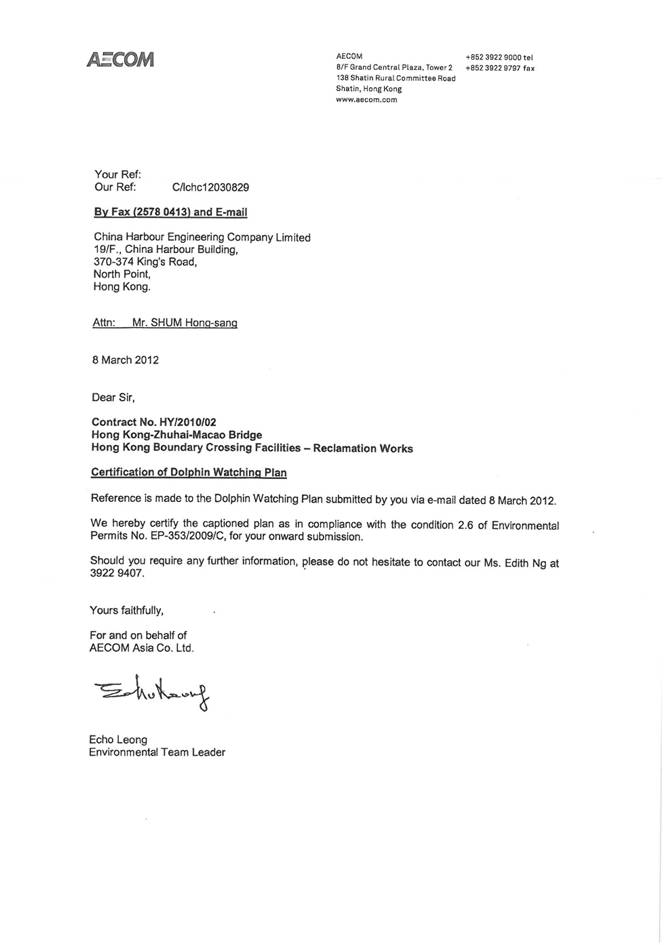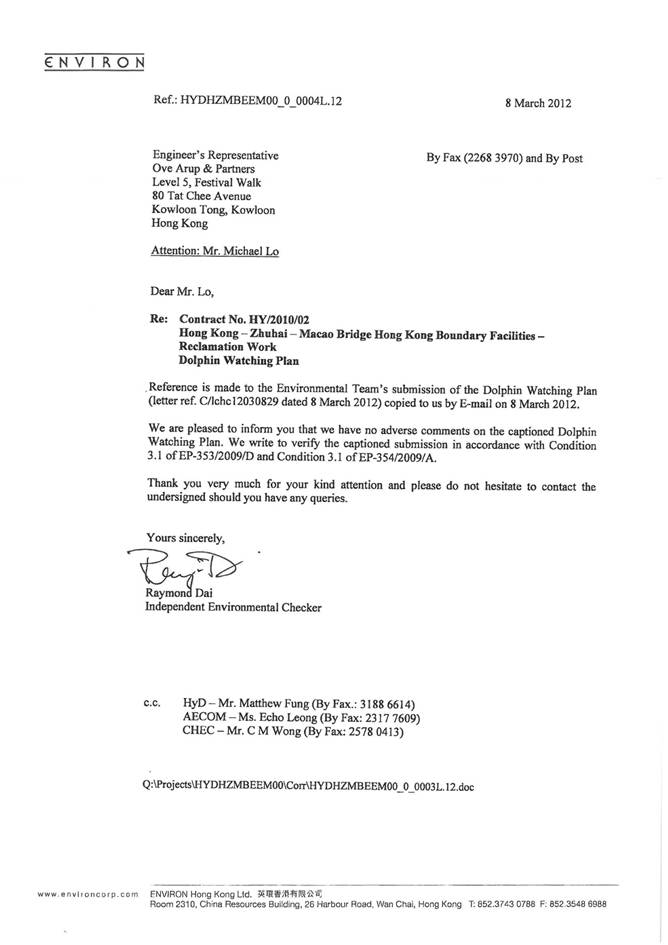


Contract
HY/2010/02
DOLPHIN
WATCHING PLAN
|
|
Name |
Signature |
|
Prepared By: |
China Harbour Engineering Company Limited |
|
1.0
Introduction
CHEC (China Harbour
Engineering Company Limited, hereafter CHEC) are the Main Contractor
responsible for the execution of the reclamation works for the Hong Kong-Zhuhai-Macao Bridge (HKZMB) - Boundary Crossing Facilities
(HKBCF) - Reclamation Works. These
works primarily involve the forming of 150 hectares of land area.
The following Dolphin Watching Plan is required under and
Sections 2.6 of Environmental Permit No. EP-353/2009/C. Noting: the Dolphin Watching Plan must
be submitted to EPD one month prior to the commencement of marine works and
specifically, the Dolphin Watch Plan must include;
“..regular inspection of the silt curtains, visual
inspection of waters surrounded by the curtains, and an action plan shall be
devised to cope with any unprecedented incidents such as the case that Chinese
white Dolphin is found within the waters surrounded by the silt curtains.”
2.0
Site Characteristics
The site area of the Hong
Kong Boundary Crossing Facilities (HKBCF) - Reclamation Works is located in the
eastern waters of the Hong Kong International Airport. The proposed location and layout is
included in Appendix I for reference.
3.0
Dolphin Watching Plan
The Dolphin Watching Plan
(DWP) shall be implemented after the silt curtains are in place. The DWP monitoring shall include visual observations
and be
conducted by a team of trained marine mammal observers (MMOs).
The MMO team shall be independent of the contractor and form part of the
Environmental Team (ET).
The MMOs shall receive specific training in this DWP. It is intended to use the
same personnel for the DWP and any other dolphin monitoring activities to maintain
consistency and establish familiarity with the works site. Additional training shall be provided
for site staff and other relevant personnel. All training shall be conducted by an experienced
dolphin specialist and shall consist
of both theory and field-based training.
Continuous assessment of MMO skills will take place. The dolphin
specialist shall
also be on site during construction operations, on a shift basis, and will be
on call for situations which require specialist instruction, advice or intervention,
such as unprecedented events such as dolphins trapped in works areas. A small vessel shall be available at all
times to support dolphin monitoring and other related activities. The main observation platform shall be a
dedicated barge with a 20m high viewing platform.
3.1 Silt Curtain Inspection for
Dolphin Intrusion into the Enclosed Area
Three
trained Marine Mammal Observers (MMOs) will use naked eye and reticle/compass binoculars to scan the area around the
works and silt curtain area. In
addition, sufficient frontline staff of foremen, superintendents and engineers
will be trained in the DWP protocol.
This is to ensure that the area enclosed by the silt curtain can also be
observed from the active works side therefore, increasing the overall ability
of dolphin detection within the area.
Prior to the start of works, the silt curtain boundary shall be
patrolled by a small vessel (with sufficient space for additional observers and
personnel) to visually inspect the integrity of the float line and the enclosed
water area. The route should be
updated as necessary in accordance with the progressing works. After the boat patrol, the area enclosed
by the silt curtain will be scanned by three MMOs and all trained
frontline staff. The MMOs will scan the area
visually (naked eye/ binoculars) from the viewing platform on the dolphin
monitoring barge and frontline staff will observe from the works site. Scanning will occur for at least 30
minutes prior to works commencement.
During works, three trained
Marine Mammal Observers (MMOs) will visually scan the area around the works and
silt curtain area. They shall work
30 minute shifts and rotate with a second team of three MMOs. The area shall be viewed from the barge
viewing platform and will provide a clear view of radius 500m-1000m around the
platform (dependent upon weather conditions). All areas within a radius of 500m from
the works will be surveyed continuously.
All sightings and locations (using distance/angle/GPS information) will
be noted and any dolphins sighted in the area will be tracked (distance and
bearing data). If, at any time, the
works has multiple active fronts, the number of observation teams can be
increased, in discussion with EPD and relevant authorities.
Every day, prior to works
cessation, a second silt net curtain inspection shall be made. A GPS track shall be stored and a log
kept for both daily inspections.
In the event that a Chinese
white dolphin (CWD) is observed within the area enclosed by the silt curtain,
all works which are occurring in the water column within the silt curtain,
e.g., dredging, reclamation, sheet piling, shall cease. MMOs on the dolphin monitoring barge
will focus on tracking the enclosed dolphin(s) while the construction site
personnel lower the float line of the silt curtain. The small dolphin monitoring vessel will
be deployed with construction site personnel and an MMO. The boat will be guided by the MMOs on
the 20m viewing tower as to the dolphin(s) movements so that the boat can be
positioned behind the dolphin(s).
The boat will slowly approach the dolphin(s) in such a manner as to
guide them towards the now lowered section of the float line. The lowered part of the boom should be
at least 5m below the water surface or as close as possible to the seabed if
the depth is less than 5m depth. As
large a length as possible, feasible and reasonable shall be lowered. Once the dolphin (s) has cleared
the net area, observations shall continue as the silt curtain float line is
re-floated. Works will recommence
when the dolphin(s) has been clear of the area for 15 minutes. This emergency
action plan shall be practiced after the first silt curtain area is enclosed so
that the procedure can be fine tuned and relevant staff familiar with their
roles. The procedure will be
practiced every second month for construction phase duration. Any changes to this emergency action
plan shall be in consultation with the relevant management authorities.
The silt curtain extends
from water surface to benthos, therefore, if CWD were to
enter the enclosed silt curtain area, it would have to leap over the float line
of the net. It may be possible a
hole develops in the silt curtain itself, and this may provide another entry
point for dolphins. Given what has
been documented for CWD, it is unlikely that a dolphin would choose to leap
over a floating boom line into a restricted area within which construction
activities are occurring. In
3.2 Silt Curtain Integrity Check
For
the silt curtain maintenance inspection itself, there will be independent
maintenance team that shall conduct dive inspections on a monthly basis, other
than the twice daily patrols conducted by the MMO and site staff teams. In the
event of a typhoon, the silt curtain will remain deployed. Once all typhoon signals are lowered, an
immediate inspection shall be made by the maintenance team to check and repair
any damage that may have occurred.
No works shall commence until this post typhoon inspection has been
made.
3.3 In
the event of injury or of live-stranded cetaceans
Currently, AFCD
are collaborating with
Ocean Park Conservation Foundation, Hong Kong (OPCF) to form
an investigation and response team that handles and investigates all marine
mammal strandings in Hong Kong. In the event that a CWD (or other
cetacean) is found injured or dead, the Stranding Programme
hotline will be called and existing AFCD/OPCF procedures put into place. Where possible, the MMOs shall assist
and facilitate any required procedures.
All MMO staff will be familiar with live and dead stranding protocols as
this will be part of MMO training.
In the event of a live stranding (of any cause) within the vicinity of
construction works, equipment for safe transfer of live cetaceans will be
available (cushioned supports/cover/ water). Such procedures will be practiced as
part of the on site training and collaboration with OPCF will be sought if
required by AFCD or management authorities.
